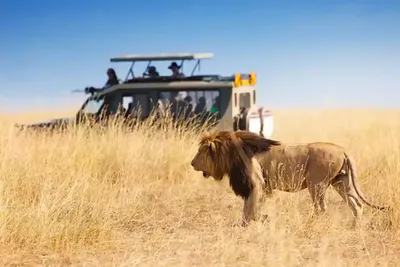
Tanzania Safari
A private safari in Tanzania can offer a more personalized and exclusive experience......
Known as the “King of the Beasts,” the African lion is arguably the most recognizable of all African wildlife. Lions inhabit vast grasslands and savannahs, living in well-organized social groups called prides. Each pride typically consists of several lionesses, their cubs, and a small number of adult males. Their deep, resonant roar, which can travel for several kilometers, not only establishes territory but also reinforces social bonds within the pride.

You can read more about lions here.
The leopard is celebrated for its stealth and striking rosette-patterned coat. As solitary and elusive predators, leopards are masters of camouflage, adapting to various environments from dense forests to open savannahs. Their ability to climb trees is legendary; they often hoist their prey up to avoid theft by scavengers. Although highly adaptable, leopards face increasing threats from habitat fragmentation and poaching.

You can read more by Leopards here !
The African elephant, the largest land animal on Earth, is a symbol of strength, wisdom, and social cohesion. Elephants are known for their long trunks, large ears, and impressive tusks. They live in matriarchal herds where older females lead the group, sharing knowledge about migration routes and water sources. These gentle giants have a significant impact on their environment, shaping landscapes and dispersing seeds across vast distances.

You can read more about Elephants here..
Africa is home to two types of rhinoceros: the black rhino and the white rhino. Despite their common name, the white rhino is not actually white; its name stems from a misinterpretation of the Afrikaans word for “wide,” referring to its broad mouth. Black rhinos are smaller and more aggressive, and are now critically endangered due to relentless poaching driven by the illegal horn trade. Both species play vital roles in their ecosystems and are the focus of significant conservation efforts.

You can read more about rhinos here.
The Cape buffalo is renowned for its unpredictable and powerful nature. Often referred to as “Black Death,” this robust herbivore is usually seen in large herds that traverse the African plains. While generally peaceful, buffaloes can become ferociously aggressive when threatened. Their strong social structure and ability to charge at high speeds make them a formidable presence in the wild.

You can read more about buffaloes here.
| Animal | Habitat | Status |
|---|---|---|
| Lion | Savannahs & Grasslands | Vulnerable |
| Leopard | Forests, Savannas, Rocky Areas | Vulnerable |
| Elephant | Savannahs, Woodlands | Vulnerable |
| Rhinoceros | Grasslands, Savannahs | Critically Endangered / Near Threatened |
| Cape Buffalo | Grasslands, Open Plains | Least Concern |
The Big Five are not just a bucket-list attraction; they are crucial components of their ecosystems. Their survival is intertwined with the health of the African wilderness. Over recent decades, conservationists and governments have worked together to implement various measures that help protect these species. These efforts include:
When tourists choose to participate in safaris that adhere to ethical guidelines, they not only enjoy an unforgettable experience but also contribute to the economic incentives that drive conservation efforts. Many private game reserves and national parks reinvest tourism revenue into anti-poaching measures, research, and community projects.
Embarking on a safari to see the Big Five is a dream come true for many wildlife enthusiasts. With careful planning and the right guidance, you can maximize your chances of experiencing these incredible animals in their natural habitat. Consider the following tips when planning your trip:
Many tour operators now offer packages that include both guided game drives and walking safaris, providing a more immersive experience. Researching in advance and reading reviews can help you choose an operator that aligns with your values and expectations.
Africa is home to numerous reserves and national parks where you can witness the Big Five. Here are a few of the top destinations:
To give you an idea of what a Big Five safari could look like, here is a sample itinerary for a 7-day adventure:
| Day | Activity |
|---|---|
| 1 | Arrival and briefing at the lodge; evening game drive |
| 2 | Early morning and late afternoon game drives; guided walk in the reserve |
| 3 | Visit a local community project; wildlife photography session |
| 4 | Full-day safari with stops at waterholes and scenic spots |
| 5 | Optional walking safari and cultural tour; relaxation at the lodge |
| 6 | Morning drive for Elephant and rhino sightings; afternoon leisure time |
| 7 | Final game drive; departure |
This itinerary is designed to maximize wildlife encounters while allowing time to appreciate the natural beauty and cultural heritage of the region.
What are Africa's Big Five?
Africa's Big Five includes the lion, leopard , African Elephant, rhinoceros, and Cape buffalo. These animals were originally grouped together by hunters due to the challenges they presented during a foot hunt.
Why are the Big Five important for conservation?
These species play crucial roles in their ecosystems and act as flagship species for conservation efforts. Protecting them helps ensure the health and balance of Africa's diverse habitats.
When is the best time to go on a safari to see the Big Five?
The best time is during the dry season, usually from May to October, when animals gather around water sources, making them easier to spot.
Which countries are top destinations for Big Five safaris?
Top destinations include South Africa, Tanzania, Kenya, and Botswana. Each offers unique experiences and excellent chances to view the Big Five in their natural habitats.
How can tourists support Big Five conservation?
By choosing ethical safari operators, participating in eco-tourism, and contributing to local conservation initiatives, tourists can help fund anti-poaching and habitat restoration efforts.
The Tanzania northern safari includes all safari options there private safari, Luxury safari, and Joining safari.